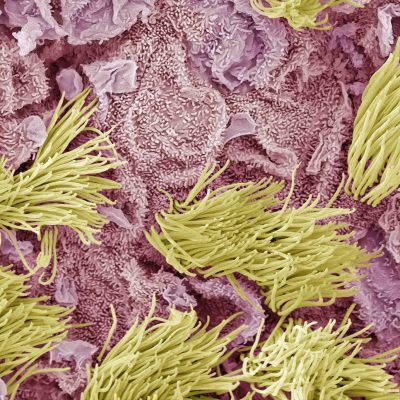
Understanding the Latest Lung Cancer Drugs
The world of cancer treatment is rapidly evolving. New therapies are being discovered, and existing ones have improved, resulting in better patient outcomes. Regional Cancer
HIPAA Alert: Potential Data Breach Learn More
Questions on Oncology, Hematology and/or Infusion Clinical Services due to COVID-19 Crisis – CALL 833-698-1623
Important Information for Our Patients Regarding the Coronavirus.
RCCA Providing Area Cancer Patients with Access to Care During Coronavirus Outbreak
RCCA Offering Patients Virtual Visits During Coronavirus Pandemic
Uterine cancer is the most common cancer of the female reproductive system. It occurs most often in postmenopausal women in their early to mid-60s, but younger women can develop the disease, too. The past decade has seen an uptick of uterine cancer among all age groups, so it’s vital that women learn to recognize its symptoms and be aware of risk factors that may increase their chances of developing the cancer.
The uterus is a hollow, pear-shaped organ. The tissue lining the wall of the uterus is called the endometrium. Most cases of uterine cancer occur in the endometrium. There are two main types of uterine cancer: endometrial cancer and uterine sarcoma. Endometrial cancer—the most common form—is the most curable gynecological cancer, especially when caught early. Uterine sarcoma is rarer, accounting for about 10% of uterine cancers. It’s harder to treat because it is more aggressive. Uterine sarcoma tends to spread to other areas of the body before it is diagnosed. By contrast, endometrial cancer is slow-growing and usually diagnosed before it spreads.
The number of new uterine cancer cases rose by 0.5% each year from 2009 through 2018, according to the National Cancer Institute. The number of uterine cancer deaths increased by 1.7% each year from 2010 through 2019. Those upward trends are of concern to board-certified gynecologic oncologist Ami Vaidya, MD, who practices with Regional Cancer Care Associates (RCCA), one of the nation’s largest networks of cancer specialists.

Dr. Vaidya sees a relationship between rising uterine cancer diagnoses and an increasingly obese population in the U.S. “Endometrial cancer incidence is on the rise, and we’re seeing it particularly in younger women who are morbidly obese,” says the physician, who practices with RCCA in Hackensack, NJ, at the John Theurer Cancer Center of Hackensack University Medical Center.
The uterine cancer-obesity connection
A 2018 study by the Centers for Disease Control and Prevention reported that women who are overweight (having a body mass index, or BMI, of 25–29.9) or obese (having a BMI of 30 or greater) are two to three times more likely to develop uterine cancer than are women who have a healthy weight.
A higher BMI is associated with endometrial cancer in women younger than 45 years. That’s likely because excess weight can cause a hormone imbalance between the hormone’s estrogen and progesterone, which counteract each other in certain ways. Overweight women produce more estrogen. Prolonged estrogen exposure is thought to play a major role in driving the cancer’s development.
This hormone imbalance is also why uterine cancer mainly affects postmenopausal women. After menopause, a woman’s ovaries stop producing both hormones. However, the fatty tissue continues to produce a small amount of estrogen, causing ongoing exposure to that hormone, without the offsetting effects of progesterone.
Other risk factors besides obesity or postmenopausal status include:
You can reduce your uterine cancer risk by maintaining a healthy weight and getting regular exercise. Other factors thought to be protective against uterine cancer include using estrogen-progestin oral contraception, having a child, and breastfeeding.
Overall, uterine cancer has a high survival rate—90% of women are alive at least five years after being diagnosed with the disease. That high rate is largely because of early diagnosis and treatment following medical evaluation of endometrial cancer’s early telltale symptom: abnormal vaginal bleeding.
Bleeding can occur for many reasons other than cancer. “That’s the number one symptom or sign that something isn’t right,” says Dr. Vaidya. “If you’re postmenopausal and experience any type of spotting, bloody discharge, or bleeding—which can be red, brown, or darkish brown—you should be evaluated by your gynecologist.”
According to Dr. Vaidya, “Younger women’s signs and symptoms are a little bit harder to discern because a woman typically is getting a menstrual cycle during her younger years. But if there’s a significant change in your menstrual cycle—such as heavy or prolonged bleeding with passage of clots, or if your periods seem to run into each other, or any type of irregular or heavier-than-usual bleeding—you should bring it to your gynecologist’s attention.”
Additional signs and symptoms of uterine cancer include:
Again, those symptoms may reflect many conditions other than uterine cancer, but you should discuss them with your physician promptly.
Unlike endometrial cancer, uterine sarcoma typically has no noticeable symptoms until the cancer has spread to other areas of the body. One sign of uterine sarcoma, though, may be an enlarged uterus, which is something your gynecologist would notice during a routine pelvic exam. That’s why Dr. Vaidya urges women not to stop annual visits to their gynecologists once they reach menopause.
“During a routine pelvic exam, your gynecologist may notice that your uterus feels larger,” she says. “See your gynecologist if you feel a change in your lower pelvis below your belly button, such as a firm, hard mass; a heavy sensation, pressure, or pain in the pelvis; or a change in bladder or bowel function.”
No screening tests are available for uterine cancer. However, a Pap test may occasionally detect abnormal cells that have shed from the uterus. This finding calls for further evaluation.
When endometrial cancer is diagnosed early and confined to the uterus, it typically is treated – and often is cured – with a total hysterectomy (removal of the uterus, including the cervix) and bilateral salpingo-oophorectomy (removal of the ovaries and both fallopian tubes). Premenopausal women who want to preserve the option of becoming pregnant and delivering a child may be candidates for fertility-sparing treatment, usually progestin therapy followed by a hysterectomy once they’re done having children. Women with more advanced disease might need chemotherapy or radiation therapy in addition to surgery.
Says Dr. Vaidya, “The most important thing that a woman who has been diagnosed with uterine cancer can do is find a group of specialists who are experienced in treating this cancer and who draw on the full range of evidence-based therapies to deliver highly individualized treatment plans and comprehensive care.”
To learn more about RCCA, call 1-844-346-7222 or visit RCCA.com.
*******
Dr. Vaidya received her medical degree from Columbia University and completed her residency in obstetrics and gynecology at New York University. She then conducted her fellowship training in gynecologic oncology at Massachusetts General Hospital. She is board-certified in gynecologic oncology, obstetrics and gynecology, and pain and palliative care. Dr. Vaidya is among the 80+ cancer specialists who treat patients at more than 26 RCCA care centers located throughout New Jersey, Connecticut, Maryland, and the Washington, DC, area. Their oncologists see more than 22,000 new patients each year and provide care to more than 225,000 established patients, collaborating closely with their patients’ other physicians. They offer patients the latest in cutting-edge treatments, including immunotherapies and targeted therapy, as well as access to a wide range of clinical trials. In addition to serving patients who have solid tumors, blood-based cancers, and benign blood disorders such as anemia, RCCA care centers also provide infusion services to people with a number of non-oncologic conditions—including multiple sclerosis, Crohn’s disease, asthma, and rheumatoid arthritis—who take intravenously-administered medications.
References
American Cancer Society. About endometrial cancer. https://www.cancer.org/cancer/endometrial-cancer/about.html. Accessed October 27, 2021.
American Cancer Society. Uterine sarcoma early detection, diagnosis, and staging. https://www.cancer.org/cancer/uterine-sarcoma/detection-diagnosis-staging.html. Accessed June 26, 2021.
American College of Obstetricians and Gynecologists. Endometrial cancer: Frequently asked questions. https://www.acog.org/womens-health/faqs/endometrial-cancer. Accessed June 23, 2021.
Centers for Disease Control and Prevention. What are the risk factors for uterine cancer? http://medbox.iiab.me/modules/en-cdc/www.cdc.gov/cancer/uterine/basic_info/risk_factors.htm. Accessed October 28, 2021.
Henley SJ, Miller JW, Dowling NF, et al. Uterine cancer incidence and mortality—United States, 1999–2016. MMWR. 2018, Dec 7;67(48):1333-1338.
MedlinePlus. Endometrial cancer. https://medlineplus.gov/ency/article/000910.htm. Accessed June 22, 2021.
MedlinePlus. Polycystic ovary syndrome. https://medlineplus.gov/ency/article/000369.htm. Accessed October 26, 2021.
National Cancer Institute. Endometrial cancer prevention (PDQ)–Patient version. https://www.cancer.gov/types/uterine/patient/endometrial-prevention-pdq. Accessed June 23, 2021.
National Cancer Institute. Endometrial cancer screening (PDQ)–Patient version. https://www.cancer.gov/types/uterine/patient/endometrial-screening-pdq. Accessed June 22, 2021.
National Cancer Institute. SEER cancer stat facts: Uterine cancer. https://seer.cancer.gov/statfacts/html/corp.html. Accessed October 18, 2021.
National Comprehensive Cancer Network. Guidelines for patients 2021: Uterine cancer. https://www.nccn.org/patientresources/patient-resources/guidelines-for-patients/guidelines-for-patients-details?patientGuidelineId=41. Accessed October 28, 2021.
Smrz SA, Calo C Fisher JL, et al. An ecological evaluation of the increasing incidence of endometrial cancer and the obesity epidemic. Am J Obstet Gynecol. 2021 May;224:506.e1-8.
UpToDate.com. Fertility preservation in patients with endometrial cancer. https://www.uptodate.com/contents/fertility-preservation-in-patients-with-endometrial-carcinoma. Accessed October 31, 2021
For more information or to schedule an appointment,
call 844-346-7222. You can also schedule an appointment by calling the RCCA location nearest you.

The world of cancer treatment is rapidly evolving. New therapies are being discovered, and existing ones have improved, resulting in better patient outcomes. Regional Cancer

The imaging tests were negative, but Elizabeth Whalen knew something was wrong. Having survived pancreatic cancer and breast cancer, the Cape May Court House resident was

When it comes to cancer, early diagnosis is a person’s best defense. Cancer cannot always be prevented, but early detection offers the best opportunity for

Regional Cancer Care Associates is one of fewer than 200 medical practices in the country selected to participate in the Oncology Care Model (OCM); a recent Medicare initiative aimed at improving care coordination and access to and quality of care for Medicare beneficiaries undergoing chemotherapy treatment.